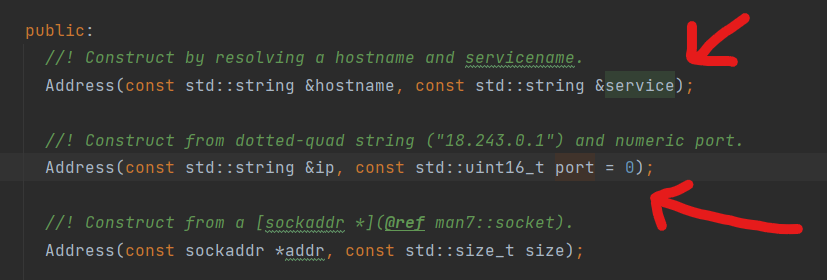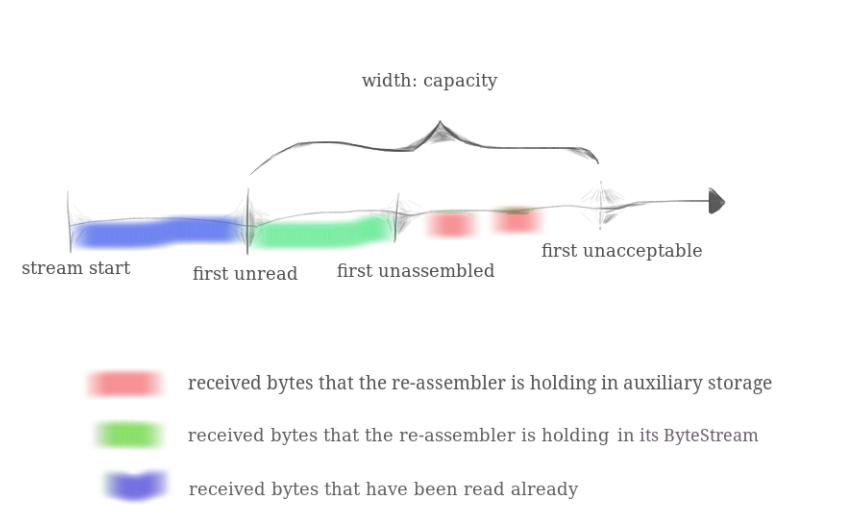cs144学习记录
cs144
斯坦福 或许博士的时候有机会遇见你吧
现在我还是乖乖找个跳板 末流211的痛,,,
video: https://www.youtube.com/watch?v=r2WZNaFyrbQ&list=PL6RdenZrxrw9inR-IJv-erlOKRHjymxMN
platform: Ed — Digital Learning Platform (edstem.org)
homework: https://cs144.github.io/
Week 1
lesson1
BitTorrent(简称BT)是一个文件分发协议,每个下载者在下载的同时不断向其他下载者上传已下载的数据。而在FTP,HTTP协议中,每个下载者在下载自己所需文件的同时,各个下载者之间没有交互。当非常多的用户同时访问和下载服务器上的文件时,由于FTP服务器处理能力和带宽的限制,下载速度会急剧下降,有的用户可能访问不了服务器。BT协议与FTP协议不同,特点是下载的人越多,下载速度越快,原因在于每个下载者将已下载的数据提供给其他下载者下载,充分利用了用户的上载带宽。通过一定的策略保证上传速度越快,下载速度也越快。在很短时间内,BitTorrent协议成为一种新的变革技术。
Skype协议(英语:Skype protocol),由Skype公司发展的专有通信协议,以点对点网络(peer-to-peer)方式创建电话网络。这个协议的内容并没有被公开发布,采用这个协议的软件,也是专有软件。
在没有获得Skype公司适当授权的前提下,Skype网络,与其他绝大多数VoIP网络间,不具互操作性。研究者以逆向工程来揭露Skype协议的内容,并根据这些已知的内容,以一些非正式的软件完成连线,来使用Skype公司提供的服务。如
Project
环境安装
直接用他给的虚拟机
1 | cs144:12345678 |
IDE Clion? 用它连一下虚拟机
还是用我自己的ubuntu,,,
搞了1h 没搞好真无语
相关包的要求
1 | clang-tidy 静态代码分析框架 |
lab0
先按要求读 documentation
看代码怎么有种当年初看吴恩达作业的感觉了,,,眼花缭乱 不知所云
wrting webget
实现 webget? 我最初写出来的是这么个玩意 但是没返回 两个可能的原因
- 没port ( 不知道为什么这里没加
- close 后面再加东西 ( 确实要加 \r\n\r\n
sock.eof() 后来查才会用
EOF是end of file的缩写,表示”文字流”(stream)的结尾。这里的”文字流”,可以是文件(file),也可以是标准输入(stdin)
1 | void get_URL(const string &host, const string &path) { |
最后的writeup 如上

好像要么指定 service 在这里是http? 要么是 port

An in-memory reliable byte stream
先来看一下 writer 感觉只有一个 FileDescriptor Class 类可以用?
可能是压根没写过c++ 看了半天还不知道如何下手,,,
要求再解读。。。太困难了,,,
- 写一个传 字节的 类似于socket 但是在内存中实现
要再内存中实现 所以我们要搞个什么数据结构来存呢? 看样子应该是 first in first out?
–> 队列!(怎么上上学期才学的 毛线都不记得了 这就是CN undegraduate education吗?
我怎么这么容易忘,,,那么问题变为 CC+中 队列怎么用
看来要先在模版里引入
(206条消息) C++ 类模板(template)详解_霸道小明的博客-CSDN博客_c++ template
一点一点来解决吧 首先 下面这个怎么写 DUMMY_CODE 伪代码的意思
即: ByteStream 如何实现
1 | ByteStream::ByteStream(const size_t capacity) { DUMMY_CODE(capacity); } |
先要定义一个 capacity?
(206条消息) c++中冒号(:)的用法_限量发行x的博客-CSDN博客_c++ 冒号
这里应该是要继承接口?
1 | ByteStream::ByteStream(const size_t capacity) : |
目前先是这样 来看看 write 即往队列中插值?
1 | // Write a string of bytes into the stream. Write as many |
data 是 string 类型 要怎么操作 一个一个写进去?
大致想法:判断是否为空 不为空则一个一个(从前往后)插入buffer中
要不停调用 wirte? 按他的意思就判断有多长 然后写进去?bytes 是不是长度还要再乘一下
(206条消息) C++中的string类用法简介_liitdar的博客-CSDN博客_c++ string
c++ | size_t - 山竹小果 - 博客园 (cnblogs.com) 用 size_t 保命 大概是这个意思 防over
1 | ByteStream::write(const string &data) { |
但是貌似没考虑溢出? 等下再说 等会看下read咋回事再说
1 | // Returns the number of additional bytes that the stream has space for |
这个要看队列里有多少个值 拿capacity_size 去减 queue.size()
1 | size_t ByteStream::remaining_capacity() const { return capacity_size - buffer.size(); } |
接下来看
1 | // Signal that the byte stream has reached its ending |
emmm 这样不知道刑不刑 但上面write就要加上一句判断了
1 | void ByteStream::end_input() { |
这个貌似要定义一个 _error 人家给好了 那没事了
1 | // Indicate that the stream suffered an error |
—–>
okk 到目前为止 write 差不多了 改 read 了 这peek 是干什么的o.o
看半天才明白 查看steam的下多少个字节
1 | // Peek at next "len" bytes of the stream |
咋 peek 出列?应该是 写!这里string可以直接加吗
很烦 到这里 没搜到遍历 queue 的方法 。。。再开一个吗?会不会比较占空间? o.o
似乎 用什么deque 可以遍历 哎 上面要重写了 好好好
1 | string ByteStream::peek_output(const size_t len) const { |
easy
1 | void ByteStream::pop_output(const size_t len) { |
read的话 直接从 buffer 中peek peek完就 pop
1 | // Read (i.e., copy and then pop) the next "len" bytes of the stream |
1 | std::string ByteStream::read(const size_t len) { |
快胜利了o.o
——————————————————>
1 | bool input_ended() const; // `true` if the stream input has ended |
怎么判断 input 结束了? 是个问题,,,
eof 怎么实现?
end_input 是记录写完? 是对于每一次来说
input_ended 是记录输入结束了 是对于整体来说
要设两个变量分别记录一下 written and read
随便写了一下 接下来就是处理一堆爆红了
终于 改了很多地方 这里就不放wp了

记录下出错的地方
1 | size_t ByteStream::write(const string &data) { |
这里不该直接加 data.length() 而要判断下data是否能写进去
1 | min(data.size(), _capacity_size - _buffer.size()); |
lab1
从原理的角度来看:
Your push substring method will ignore any portion of the string that would cause the StreamReassembler to exceed its “capacity”`
现在来分析一下这句话讲的是什么意思
这似乎是可靠数据传输原理里的一种需求
实验目的 把stream 的一些(可能为乱序)的片段重新组装
但是?我怎么判断他们的数据 有个标志?
确实是这样 有个 index 这个lab要实现的功能并不多
要求:
TCP sender 将其字节流分成短段(每个子串不超过约1460字节),以便它们都适合数据报。但是网络可能会重新排序这些数据报,或者丢弃它们,或者不止一次地传递它们。接收器必须将这些段重新组合成它们开始时的连续字节流。
所以我们要做的:
- 判断是否重复?
- 是否有缺失?
- 重新排序
考虑一下需要增加的变量 :
需要搞一个来记录一下是否出现过?或者说判断deque中相对应的 index 是否为空?
但我们只有两种插入的方法 头插和尾插
最好的方法感觉就是先给他排好序再插到 _buffer 里面
然后再来一个write 直接就写进去了
所以 https://blog.csdn.net/liitdar/article/details/80498634
找到了 insert 方法
如果是空格就给他替换掉?不是空格就跳过?
~~看来不能直接全部replace 还是先 insert 再说~~~~
真实地情况

可以看到的是 他的 capacity 包括了两个部分 第一部分是 已经存到 ByteStream 的 _bufffer 中的
第二部分是 已经收到的但暂时存起来的
问题来了 什么时候放到 auxiliary storage 中?
如果 待 push 的 index 不等于 绿色中最后一个 segment 的 index +1 就需要放进 auxiliary storage 中等待
map 能用吗?学一下 c++的map
1 | // Construct a `StreamReassembler` that will store up to `capacity` bytes. |
首先 搞明白一个东西 拿什么东西 去存组成的stream
之前的 ByteStream
1 | ByteStream::ByteStream(const size_t capacity) |
这个函数的实现是重点
1 | //! \brief Receive a substring and write any newly contiguous bytes into the stream. |
超出了 throw eof
没有超出 把 &data 加到 _buffer 里面? 需要先好好理解一下他这个 index
param index indicates the index (place in sequence) of the first byte in
data
那我们用什么办法给他插入 deque 里面呢?
1 |
|
乱写了一点 过了 63% 明天再接着写 写的头晕了
1 | void StreamReassembler::push_substring(const string &data, const size_t index, const bool eof) { |